Nucleus of a (lead) isotope: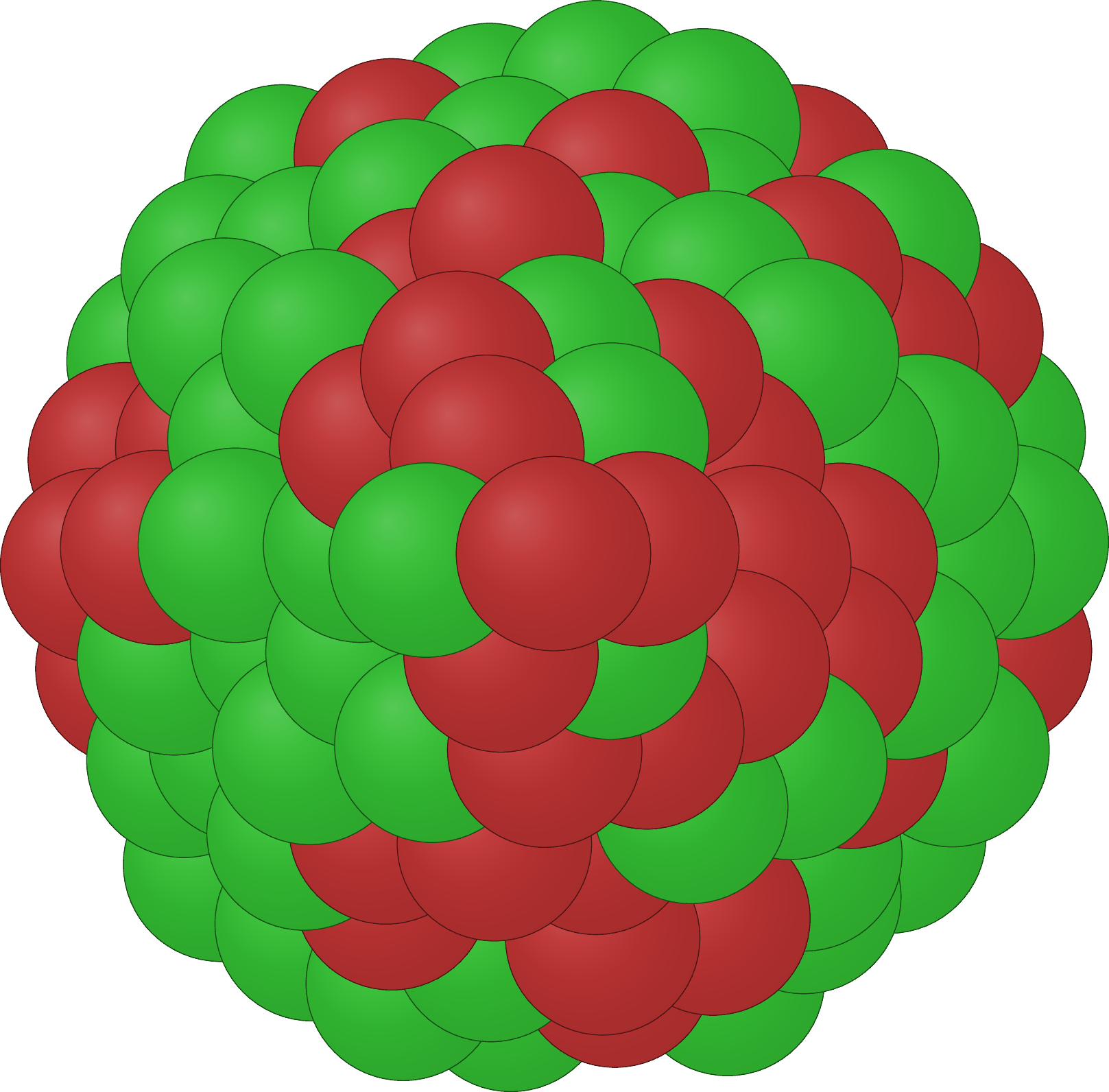 Lead-lead (PbPb) collisions at the LHC with electromagnetic fields (note Lorentz-contraction):
Lead-lead (PbPb) collisions at the LHC with electromagnetic fields (note Lorentz-contraction):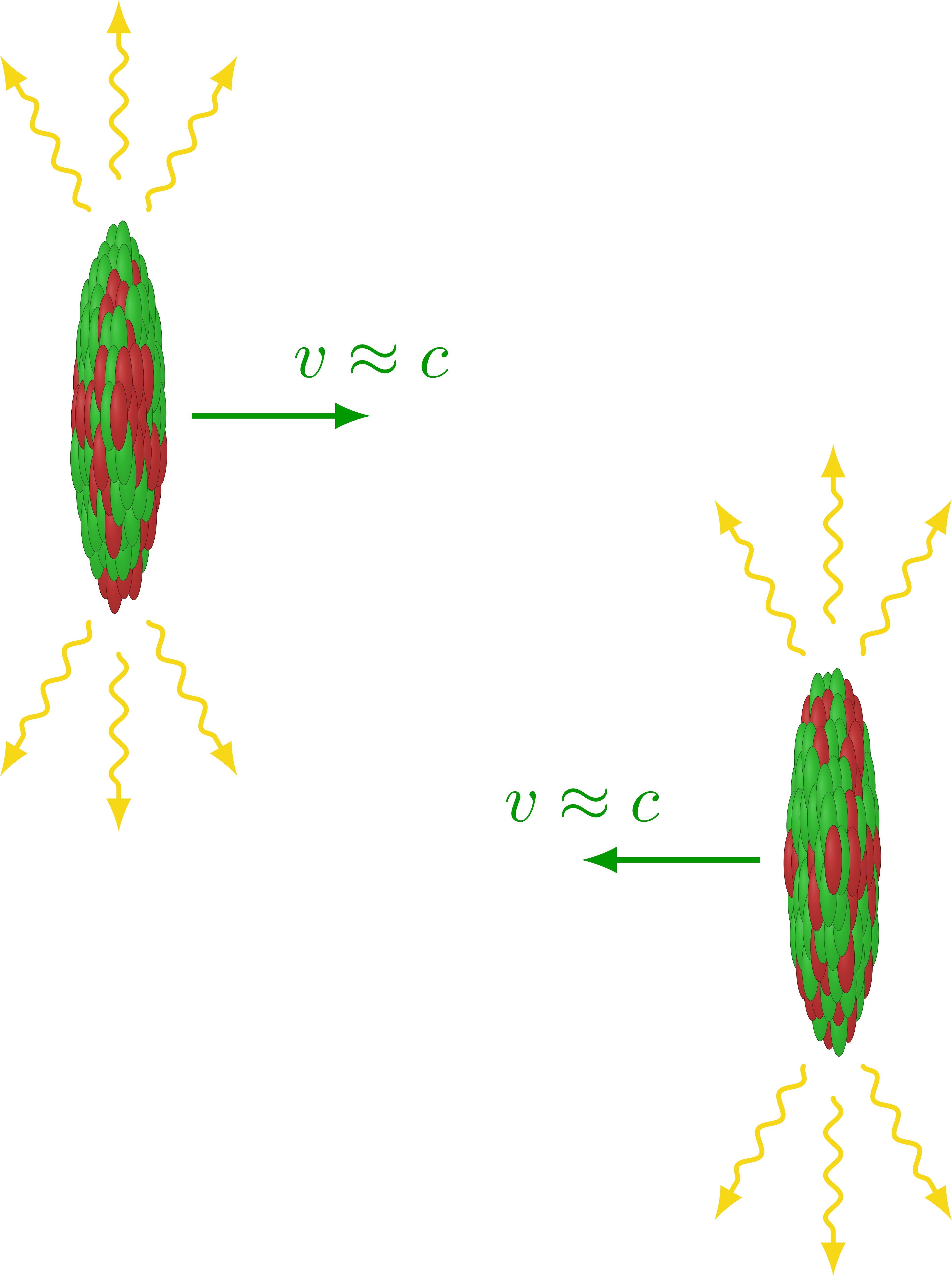 Indicating the impact parameter:
Indicating the impact parameter:
 This did not fill up so evenly as I wanted, so I tried to generate the nucleons uniformly on ring layers using polar coordinates:
This did not fill up so evenly as I wanted, so I tried to generate the nucleons uniformly on ring layers using polar coordinates: Adding a bit of random offsets to the angle and radius in the polar coordinate:
Adding a bit of random offsets to the angle and radius in the polar coordinate: Randomly shuffling the nucleons along the rings so the overlap of consecutive balls is not regular, and the even/odd coloring looks more random:
Randomly shuffling the nucleons along the rings so the overlap of consecutive balls is not regular, and the even/odd coloring looks more random: The rings have constant distance between them because each ring's radius is set with a simple linear equation of the form
The rings have constant distance between them because each ring's radius is set with a simple linear equation of the form 
Click to download: PbPb_collisions.tex • PbPb_collisions.pdf
Open in Overleaf: PbPb_collisions.tex
 Lead-lead (PbPb) collisions at the LHC with electromagnetic fields (note Lorentz-contraction):
Lead-lead (PbPb) collisions at the LHC with electromagnetic fields (note Lorentz-contraction): Indicating the impact parameter:
Indicating the impact parameter:
Main idea
At first I tried randomly assigning an angle and radius (samplingsqrt((rand+1)/2) for uniform distribution along the radius): This did not fill up so evenly as I wanted, so I tried to generate the nucleons uniformly on ring layers using polar coordinates:
This did not fill up so evenly as I wanted, so I tried to generate the nucleons uniformly on ring layers using polar coordinates: Adding a bit of random offsets to the angle and radius in the polar coordinate:
Adding a bit of random offsets to the angle and radius in the polar coordinate: Randomly shuffling the nucleons along the rings so the overlap of consecutive balls is not regular, and the even/odd coloring looks more random:
Randomly shuffling the nucleons along the rings so the overlap of consecutive balls is not regular, and the even/odd coloring looks more random: The rings have constant distance between them because each ring's radius is set with a simple linear equation of the form
The rings have constant distance between them because each ring's radius is set with a simple linear equation of the form r=R*i/N. To make the nucleus look more like a 3D sphere, we can gradually pull the outers rings closer together by reducing the ring radius quadratically: r'=r-C*r^2 for some tunable parameter C ~ 0.2:
% Author: Izaak Neutelings (March 2024)
% Description: Lead-lead collisions
\documentclass[border=3pt,tikz]{standalone}
\usepackage{amsmath}
\usepackage{listofitems} % to create arrays with \readlist
\usepackage{ifthen} % for \whiledo
%\usetikzlibrary{arrows.meta} % for arrow size
% COLORS
\colorlet{myred}{red!75!black}
\colorlet{myblue}{blue!70!black}
% STYLES
\tikzset{
>=latex, % for LaTeX arrow head
ball/.style={ultra thin,draw=black,fill=\getcol{#1},
circle,inner sep=1pt,minimum size=15pt,scale=0.8},
ball/.default=1,
}
\def\getcol#1{\ifodd#1 blue!20 \else red!20 \fi}
\def\drawgrid#1{
\pgfmathsetmacro\xmax{ceil(#1)+0.6}
\pgfmathsetmacro\xmin{0.3-\xmax}
\draw[black!20] (\xmin,\xmin) grid (\xmax,\xmax);
\draw[thick,->] (\xmin,0) -- (\xmax,0);
\draw[thick,->] (0,\xmin) -- (0,\xmax);
\draw[black!20] (0,0) circle(#1);
}
\begin{document}
% NUCLEUS - random radius & angle
\def\R{2.0}
\def\Nlay{5} % number of rings/layers
\def\N{100}
\begin{tikzpicture}
\drawgrid{\R}
% NUCLEUS
\foreach \i [evaluate={
\r=\R*sqrt((rand+1)/2); % ball radius
\a=180*rand % ball angle
}] in {1,...,\N}{
\node[ball=\i] at (\a:\r) {\i};
}
\end{tikzpicture}
% NUCLEUS - uniform rings
\begin{tikzpicture}
\message{^^JNucleus with uniform rings}
\drawgrid{\R}
% NUCLEUS
\foreach \lay [evaluate={
\r=\R*\lay/\Nlay; % ring radius
\Nring=int(round(2*\lay*\N/(\Nlay*(\Nlay+1)))) % number of balls per ring
}] in {\Nlay,...,1}{
\message{^^J N=\N, Nlay=\Nlay, Nring=\Nring, r=\r}
\foreach \i [evaluate={
\a=360*(\i/\Nring); % ball angle
}] in {1,...,\Nring}{
\node[ball=\i] at (\a:\r) {\i};
}
}
\end{tikzpicture}
% NUCLEUS - uniform rings + random offset
\begin{tikzpicture}
\message{^^JNucleus with uniform rings + random offset}
%\def\R{1.8}
\drawgrid{\R}
% NUCLEUS
\foreach \lay [evaluate={
\r=\R*(\lay-0.1)/\Nlay; % ring radius
\aR=3*rand; % angular offset
\Nring=int(round(2*\lay*\N/(\Nlay*(\Nlay+1)))) % number of balls per ring
}] in {\Nlay,...,1}{
\message{^^J N=\N, Nlay=\Nlay, Nring=\Nring, r=\r}
\foreach \i [evaluate={
\aB=\aR+360*(\i/\Nring)+2*rand/\Nring; % ball angle plus random offset
\rB=\r+0.04*rand % ball radius plus random radial offset
}] in {1,...,\Nring}{
\node[ball=\i] at (\aB:\rB) {\i};
%\fill[red] ({\aR+360*(\i/\Nring)}:\r) circle(0.5pt);
}
}
\end{tikzpicture}
% NUCLEUS - shuffle balls
\def\shufflelist#1{
%\message{^^JShuffle list}
\pgfmathsetmacro\tmplist{random(1,#1)} % first random item
\readlist*\shuffledlist\tmplist % convert to array
\newboolean{unique}
\whiledo{\shuffledlistlen<#1}{ % try until list is of length \N=#1
\pgfmathsetmacro\rx{random(1,#1)} % generate new random item
\setboolean{unique}{true}
\foreachitem \x \in \shuffledlist{ % loop over previous elements
\ifnum \x=\rx % look if new number in list
\setboolean{unique}{false} % already in list
\breakforeach
\fi
}
\ifthenelse{\boolean{unique}}{ % found unique item !
\xdef\tmplist{\tmplist,\rx} % add new unique item
\readlist*\shuffledlist\tmplist % convert to array
}{}
}
}
\begin{tikzpicture}[xscale=1]
\message{^^JNucleus with shuffling balls}
%\def\R{1.8}
\drawgrid{\R}
\pgfmathsetseed{1234567890}
% NUCLEUS
\foreach \lay [evaluate={
\r=\R*(\lay-0.1)/\Nlay; % ring radius
\aR=3*rand; % angular offset
\Nring=int(round(2*\lay*\N/(\Nlay*(\Nlay+1)))) % number of balls per ring
}] in {\Nlay,...,1}{
\message{^^J N=\N, Nlay=\Nlay, Nring=\Nring, r=\r}
\shufflelist{\Nring} % get shuffled list of sequence 1,...,\Nring
\foreach \i [evaluate={
\is=int(\shuffledlist[\i]); % shuffled index
\aB=\aR+360*(\is/\Nring)+2*rand/\Nring; % ball angle plus random offset
\rB=\r+0.04*rand % ball radius plus random radial offset
}] in {1,...,\Nring}{
\message{^^J is=\is, i=\i, a=\aB}
\node[ball=\i] at (\aB:\rB) {\i};
%\fill[red] ({\aR+360*(\i/\Nring)}:\r) circle(0.5pt);
}
}
\node[ball=\i] at (0,0) {0}; % cover hole
\end{tikzpicture}
% NUCLEUS - 3D effect
\begin{tikzpicture}[xscale=1]
\message{^^JNucleus with 3D effect}
%\def\R{1.8}
\drawgrid{\R}
\pgfmathsetseed{1234567890}
% NUCLEUS
\pgfmathsetmacro\C{min(1/(4*\R),0.11)} % put balls at edges closer in to create 3D ball effect
\pgfmathsetmacro\D{1-4*\C*\R} % discriminant
\message{^^J R=\R, C=\C, D=1-4cR=\D (must be >0)}
\pgfmathsetmacro\Rs{2*\R/(1+sqrt(\D)} % scaled total radius
\foreach \lay [evaluate={
\r=\Rs*(\lay-0.1)/\Nlay; % ring radius
\rC=\r-\C*\r*\r; % reduce outer radii to create 3D effect
\aR=3*rand; % angular offset
\Nring=int(round(2*\rC*\N/(\Rs*(\Nlay+1)*(1-\C*\Rs*(2*\Nlay+1)/(3*\Nlay))))) % number of balls on this ring
}] in {\Nlay,...,1}{
\message{^^J N=\N, Nlay=\Nlay, Nring=\Nring, r=\r}
\shufflelist{\Nring} % get shuffled list of sequence 1,...,\Nring
\foreach \i [evaluate={
\is=int(\shuffledlist[\i]); % shuffled index
\aB=\aR+360*(\is/\Nring)+2*rand/\Nring; % ball angle plus random offset
\rB=\rC+0.05*rand % ball radius plus random radial offset
}] in {1,...,\Nring}{
\message{^^J is=\is, i=\i, a=\aB}
\node[ball=\i] at (\aB:\rB) {\i};
%\fill[red] ({\aR+360*(\i/\Nring)}:\r) circle(0.5pt);
}
}
\node[ball=\i] at (0,0) {0}; % cover hole
\end{tikzpicture}
\end{document}
Full code
Edit and compile if you like:
% Author: Izaak Neutelings (March 2024)
% Description: Lead-lead collisions
% Inspiration: https://arxiv.org/abs/2010.07855
\documentclass[border=3pt,tikz]{standalone}
\usepackage{listofitems} % to create arrays with \readlist
\usepackage{ifthen} % for \whiledo
\usepackage{siunitx} % for \SI
\usetikzlibrary{decorations.pathmorphing} % for snake, coil, zigzag
% COLORS
\colorlet{protoncol}{red!68!black!80}
\colorlet{neutroncol}{green!68!black!80}
\colorlet{photoncol}{yellow!85!orange!95!black}
% STYLES
\tikzset{
>=latex, % for LaTeX arrow head
vector/.style={->,thick,green!60!black},
photon/.style={->,line width=0.7,line cap=round,photoncol,decorate,decoration={
snake,amplitude=.4mm,segment length=2.2mm,post length=1.5mm}
},
ball/.style={
circle,draw=none,ball color=#1,postaction={
fill=#1,fill opacity=0.8,draw=#1!40!black,line width=0.04}
},
ball/.default=protroncol,
pics/nucleus/.style={%
code={%
\fill[protoncol] (0,0) circle(0.86*\R); % background to fill any holes
\pgfmathsetmacro\Rball{0.18*\R} % ball radius
\pgfmathsetmacro\Rcorr{\R-\Rball} % subtract ball radius
\pgfmathsetmacro\C{min(1/(4*\Rcorr),0.24)} % put balls at edges closer in to create 3D ball effect
\pgfmathsetmacro\D{1-4*\C*\Rcorr} % discriminant
\pgfmathsetmacro\Rs{2*(\Rcorr)/(1+sqrt(\D)} % scaled total radius
\message{^^J R=\R, R=\Rcorr, Rs=\Rs, C=\C, D=1-4cR=\D (must be >0)}
\foreach \lay [evaluate={
\r=\Rs*(\lay-0.05)/\Nlay; % ring radius
\rC=\r-\C*\r*\r; % reduce outer radii to create 3D effect
\aR=3*rand; % random angular offset
\Nring=int(round(2*\rC*\N/(\Rs*(\Nlay+1)*(1-\C*\Rs*(2*\Nlay+1)/(3*\Nlay))))) % number of balls on this ring
}] in {\Nlay,...,1}{
\message{^^J N=\N, Nlay=\Nlay, Nring=\Nring, r=\r}
\shufflelist{\Nring} % get shuffled list of sequence 1,...,\Nring
\foreach \i [evaluate={
\p=(rand+1)/2<0.39?1:0; % 0: neutron, 1: proton
\is=int(\shuffledlist[\i]); % shuffled index
\aB=\aR+360*(\is/\Nring)+2*rand/\Nring; % ball angle plus random offset
\rB=\rC+0.04*rand % ball radius plus random radial offset
}] in {1,...,\Nring}{
%\message{^^J is=\is, i=\i, a=\aB, p=\p}
\fill[ball=\ifodd\p protoncol\else neutroncol\fi]
(\aB:\rB) circle(\Rball);
}
}
\fill[ball=protoncol] (0,0) circle(\Rball);
\foreach \ang in {0,60,90,120,180,-60,-90,-120}{
\coordinate (-\ang) at (\ang:\R+1.3*\Rball);
}
}
}
}
\def\shufflelist#1{ % get shuffled list of sequence 1,...,#1
%\message{^^JShuffle list}
\pgfmathsetmacro\tmplist{random(1,#1)} % first random item
\readlist*\shuffledlist\tmplist % convert to array
\newboolean{unique}
\whiledo{\shuffledlistlen<#1}{ % try until list is of length = #1
\pgfmathsetmacro\rx{random(1,#1)} % generate new random item
\setboolean{unique}{true}
\foreachitem \x \in \shuffledlist{ % loop over previous elements
\ifnum \x=\rx % look if new number in list
\setboolean{unique}{false} % already in list
\breakforeach % stop looking and try again in next iteration
\fi
}
\ifthenelse{\boolean{unique}}{ % found unique item !
\xdef\tmplist{\tmplist,\rx} % add new unique item
\readlist*\shuffledlist\tmplist % convert to array
}{}
}
}
\begin{document}
% Pb nucleus
\def\N{85} % number of nucleons
\def\R{1.0} % nucleus radius
\def\Nlay{5} % number of rings/layers
\begin{tikzpicture}
\message{^^J Pb nucleus}
% NUCLEUS
\pic {nucleus};
\end{tikzpicture}
% Pb-Pb collision
\def\xs{0.25} % horizontally scale
\def\Rp{0.92} % length photon
\def\D{3.7} % horizontal distance between nuclei
\pgfmathsetmacro\H{2.30*\R} % vertical distance between nuclei
\pgfmathsetmacro\v{0.25*\D} % length vector
\begin{tikzpicture}
\message{^^J PbPb collision}
% NUCLEUS
\pic[xscale=\xs] (L) at (-\D/2, \H/2) {nucleus};
\pic[xscale=\xs] (R) at ( \D/2,-\H/2) {nucleus};
% VELOCITY VECTORS
\draw[vector] (L-0)++(2pt,0) --++ (\v,0) node[above=2pt] {$v\approx c$};
\draw[vector] (R-180)++(-2pt,0) --++ (-\v,0) node[above=2pt] {$v\approx c$};
% PHOTONS
\foreach \ang in {60,90,120,-60,-90,-120}{
\draw[photon] (L-\ang) --++ (\ang:\Rp);
\draw[photon] (R-\ang) --++ (\ang:\Rp);
}
\end{tikzpicture}
% Pb-Pb collision with impact parameter
\begin{tikzpicture}
\message{^^J PbPb collision with impact parameter}
% NUCLEUS
\pic[xscale=\xs] (L) at (-\D/2, \H/2) {nucleus};
\pic[xscale=\xs] (R) at ( \D/2,-\H/2) {nucleus};
% VELOCITY VECTORS
\draw[vector] (L-0)++(2pt,0) --++ (\v,0); %node[above=2pt] {$v\approx c$};
\draw[vector] (R-180)++(-2pt,0) --++ (-\v,0); %node[above=2pt] {$v\approx c$};
% PHOTONS
\foreach \ang in {60,90,120,-60,-90,-120}{
\draw[photon] (L-\ang) --++ (\ang:\Rp);
\draw[photon] (R-\ang) --++ (\ang:\Rp);
}
% MEASURES
\draw[<->,thick]
(R-0)++(0.3*\R,0) --++ (0,\R) node[midway,right] {$R\sim\SI{7}{fm}$};
\draw[<->,thick]
(0,-\H/2) -- (0,\H/2) node[midway,right] {$b$};
\node at (0.3*\D,0.7*\H) {$b > 2R$};
\end{tikzpicture}
\end{document}Click to download: PbPb_collisions.tex • PbPb_collisions.pdf
Open in Overleaf: PbPb_collisions.tex


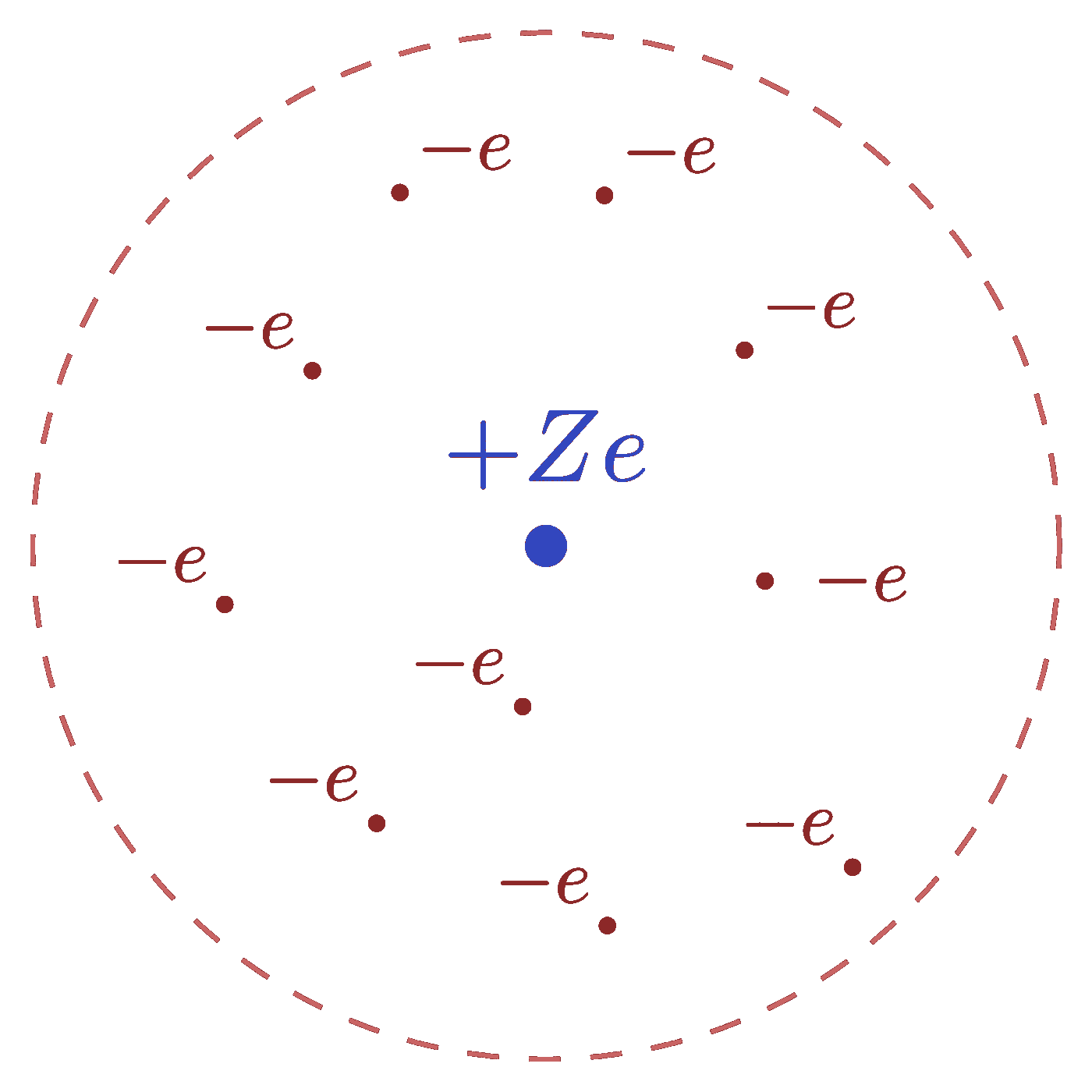


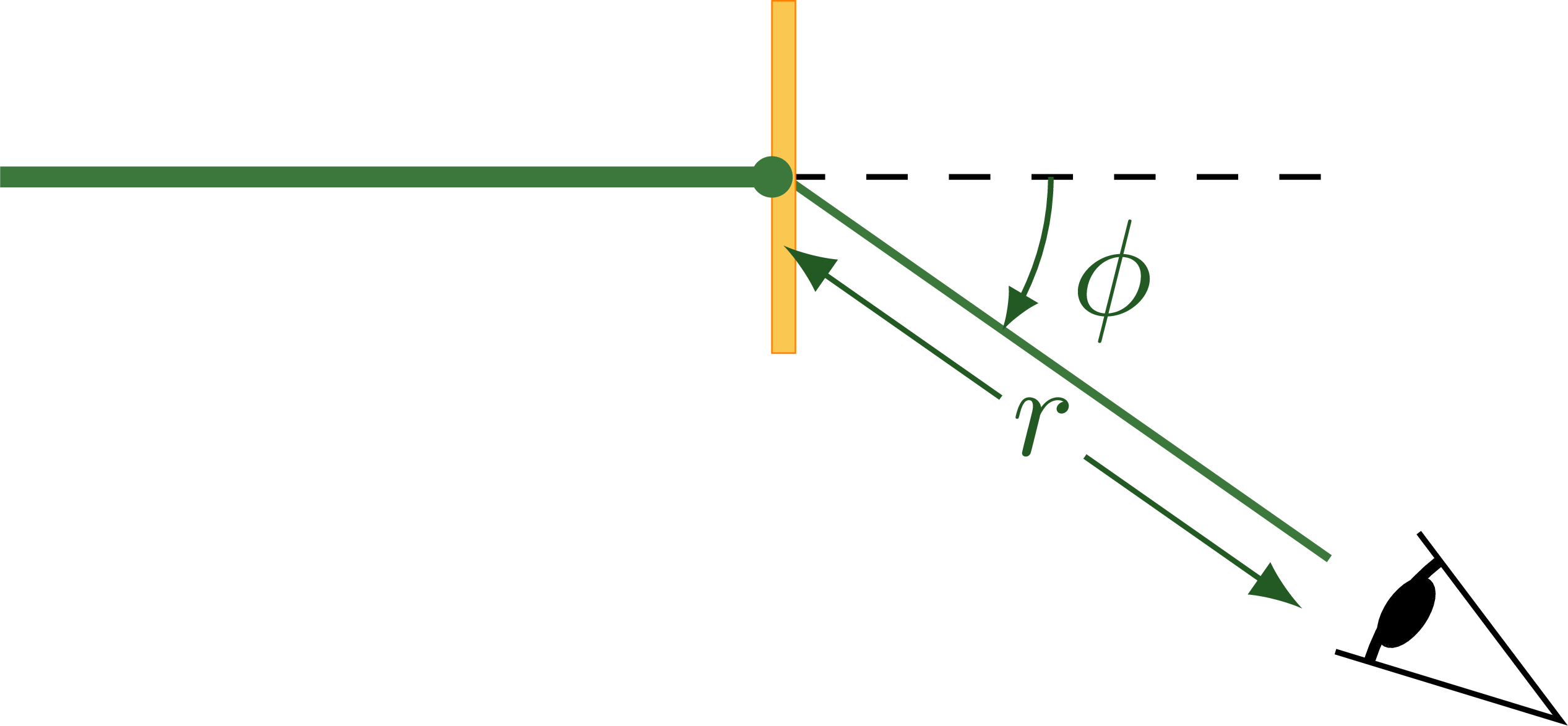
Dear authors,
I want to reuse this figure along with a few others with minor modifications in my thesis paper. How can I cite them in bibtex ?
1) https://tikz.net/pbpb_collisions/
2) https://tikz.net/axis3d_cms/
3) https://tikz.net/transverse_plane/
4) https://tikz.net/bsm_longlived/
5) https://tikz.net/sm_z_decay/
6) https://tikz.net/vertex_diphoton/
7) https://tikz.net/control_region_abcd/
8) https://tikz.net/jet_cone/
9) https://tikz.net/tau_decay_xmas/
10) https://tikz.net/sm_particles/
Thank you very much.
Regards,
Bharadwaj
Hi Bharadawaj,
Thank you for your message.
Almost everything on this website is under open creative license. How exactly you cite it is up to you. You could include something like the following in the BibTex file:
@misc{cms_coordinate_system,
author = "{Neutelings, Izaak}",
title = {{CMS coordinate system -- TikZ.net}},
year = {2021},
url = {https://tikz.net/axis3d_cms/},
note = {(Retrieved May 28, 2024)}
}
And add the reference at the end of the figure caption with something like
"Taken from Ref.~\cite{...}."or"Courtesy of Izaak Neutelings~\cite{...}.". If you make some nontrivial changes to the figures, perhaps you can writeAdapted from Ref.~\cite{...}.".Good luck!
Izaak